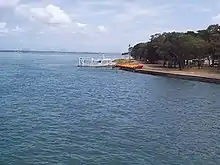| Pumicestone Channel | |
|---|---|
 High tide at Bellara, Pumicestone Channel | |
| Details | |
| Location | Queensland, Australia |
| Coordinates | 26°56′22″S 153°04′11″E / 26.9394°S 153.0698°E |
| Length | 35km |
| North end | Caloundra |
| South end | Deception Bay |

Pumicestone Channel, also known as the Pumicestone Passage, is a narrow, mesotidal waterway around 45 kilometres in length, between Bribie Island and the mainland in Queensland, Australia.[1] The northern extent of the passage is at Caloundra, while at the south is Deception Bay. The waterway is a two way tidal estuary that has 11 creeks flowing into it.[2] At each end of the passage the channels are the deepest and widest.[2]
During periods of unusually high tides and large waves, the passage is infiltrated by inflows through channels in dunes at the northern tip of Bribie Island.[3]
History
The channel was originally shown as Pumice-stone River on the maps of Matthew Flinders as he found an abundance of pumice stone lining the shoreline. He was the first European explorer to enter Moreton Bay in 1799 on the Sloop H. M. 'Norfolk' and spent two weeks exploring the bay and surrounds and naming Point Skirmish and Pumice-stone River. [4]
In January 2022, a breakthrough on Bribie Island occurred, severing the island into two parts.[5] The main channel for Pumicestone Passage moved south to the inflow.[6] Since then the Caloundra Bar has become filled with sand.[5] The changes have raised concerns with water quality at the northern end of the passage.[5]
Environment
Gazetted in 1986, Pumicestone Passage Marine Park (now part of the Moreton Bay Marine Park), extends from the southern entrance at the towns of Bribie Island and Sandstone Point, north to the Caloundra bar. It is just over 35 kilometres long and has a surface area of 63 km². The town of Bribie Island comprises suburbs of Bongaree, Woorim, Bellara, Banksia Beach and White Patch. Bribie Island is reached by a Bridge of 800m length over the Pumicestone Passage.The marine park has 24 islands and is bounded by 240 kilometres of shoreline. Eighty percent of the channel is less than two metres deep and dugongs frequent its waters seasonally to feed on the seagrass on the bottom of the channel. Dolphins and turtles also make the channel home as do over 350 species of birds. Habitats within and adjoining the channel include mangroves and saltmarshes, sand flats and mud flats, coastal dunes and seagrass meadows.[7][8] [9] The channel forms part of the Moreton Bay and Pumicestone Passage Important Bird Area, so identified by BirdLife International because it supports large numbers of migratory waders, or shorebirds.[10]
See also
References
- ↑ "Pumicestone Channel – channel (entry 27629)". Queensland Place Names. Queensland Government. Retrieved 23 March 2021.
- 1 2 Graham, Bruce (2004). The Green Coast: The Natural Environment of the Tweed-Moreton Bioregion. Tweed Heads, New South Wales. p. 145. ISBN 0-9751817-0-X. Archived from the original on 15 November 2021. Retrieved 29 January 2022.
{{cite book}}: CS1 maint: location missing publisher (link) - ↑ Stevenson, Ashleigh (15 December 2020). "Bribie Island erosion worries authorities as wild weather continues to whip the region". ABC News. Australian Broadcasting Corporation. Archived from the original on 16 December 2020. Retrieved 25 November 2021.
- ↑ "The Matthew Flinders Bicentenary Association". Archived from the original on 17 November 2007. Retrieved 14 January 2008.
- 1 2 3 Taylor, Steele (27 July 2023). "Locals hold concerns over future of water quality in passage as testing continues". Sunshine Coast News. Retrieved 29 July 2023.
- ↑ Taylor, Steele (5 February 2023). "In Photos: See how the Bribie breakthrough has impacted its surrounds in 12 months". Sunshine Coast News. Retrieved 29 July 2023.
- ↑ "Bridie Island Tourist Information". Archived from the original on 14 September 2007. Retrieved 14 January 2008.
- ↑ Victoria Education website Archived 2007-11-17 at the Wayback Machine
- ↑ Queensland things to do website Archived 2007-10-09 at the Wayback Machine
- ↑ "IBA: Moreton Bay and Pumicestone Passage". Birdata. Birds Australia. Archived from the original on 6 July 2011. Retrieved 17 August 2011.
